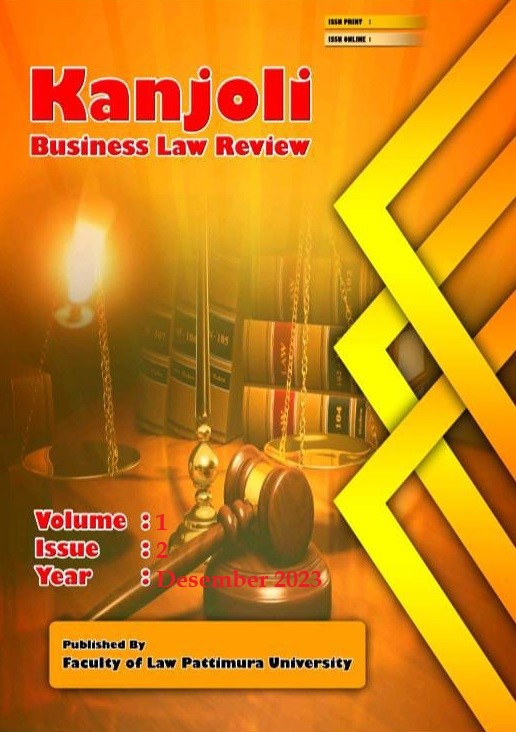Kekuatan Hukum Covernote Notaris Dalam Proses Takeover Perjanjian Kredit
Abstract
with the debtor or something related to the Notary's Duties and Authorities in accordance with Law Number 30 of 2004. One form of Notary authority over the Credit agreement is by issuing a Covernote. In fact, Covernote is not regulated in the Law, so it is necessary to review the legal force of Covernote. Notary in Credit process at Banks and how the legal consequences of Notary Covernote on Debtors and Creditors. To know and explain, related to the form of Notary Covernote Legal Power in the Credit Agreement Takeover Process. Normative juridical methods, which will certainly be studied more deeply based on positive legal provisions, as well as legal principles. as well as using primary, secondary and tertiary legal materials. From the results of the study, it is known that Notary Covernote in terms of credit disbursement by the Bank to its customers serves only as a bank handle. Covernote as a notary legal product has no legal effect, because Covernote is not an authentic deed or a separate deed, but only an ordinary letter explaining the ability or notary information to complete the unfinished process. Notary negligence in fulfilling what is stated in the Covernote will cause losses / legal consequences for the bank as a creditor where the guarantee engagement can be considered a failure, while the credit agreement is still ongoing, and on the debtor side it will incur new costs if re-engagement must be made, and also the notary can be criminally prosecuted, if it turns out that in making the Covernote there is an element of notary negligence on the validity and correctness of the document. So to avoid this, a legal umbrella / law is needed that regulates the use / issuance of Covernote to protect the interests of banks, debtors and limited against notaries.
Downloads
References
Jurnal
Haliwela, Nancy Silvana “Rekaman Pembicaraan Telepon sebagai Alat Bukti Perjanjian Bank dengan Nasabah pada Bancassurance” ADHAPER: Jurnal Hukum Acara Perdata Vol 1 No 2 Juli-Desember 2015, h.158
Sanjaya, I. D. M. D. Tanggung Jawab Seorang Notaris Pada Penerbitan Covernote Kredit. Riau Law Journal, 1(2), Hal.180-204.183
Rahmiah Kadir dkk, Pertanggungjawaban Notaris Pada Penerbitan Covernote, Mimbar Hukum, Vol. 31, No.2 (Makassar: Fakultas Hukum Universitas Hasanuddin, 2019) Hal.192
Muhayminah, M., Kamello, T., Barus, U. M., & Sembiring, R. (2017). Pemberian Kredit dengan Jaminan Tanah Surat Keterangan (Sk) Camat pada PT. Bank Rakyat Indonesia (Persero) Tbk. Cabang Medan Sisingamangaraja. USU Law Journal, 5(1). 51-65. Hal. 59
Buku
Rachmat Firdaus dan Maya Ariyanti Vol. 1 No. 1 (2017): ACTA DIURNAL Jurnal Ilmu Hukum Kenotariatan Volume 1, Nomor 1, Desember 2017 “Covernote notaris dalam perjanjian kredit dalam perspektif hukum jaminan” Hal 87
Mukti, A. M. (2018). Peran notaris dalam memberikan covernote pada perjanjiian kredit antar bank dengan jaminan HT (Studi Kasus di Kantor Notaris-PPAT Dr. I Gde Mastra (Kota Malang) (Doctoral dissertation, University of Muhammadiyah Malang) Hal.48
Siska Novista, Program magister kenotariatan program pasca sarjana fakultas hukum Universitas Islam Indonesia Yogyakarta 2018 “Tanggung Jawab Notaris/PPAT Dalam Mengeluarkan Covernote”, Hal. 4
Online/Online/World Wide Web, Dan Lain-Lain
Biro Humas dan HLN. Hasbullah, Notaris dan Jaminan Kepastian Hukum, http://www.wawasanhukum.blogspot.com, diakses pada 07 Juli 2023
Inisi dan Mekanisme Takeover (Subrogasi) dalam Dunia Perbankan, https://akuntansi.blogspot.com/2013/09/definisi-dan-mekanisme-takeover.html (Diakses pada 04 April 2023)
Royani, Lilin, Hernawan Hadi, and Muhammad Hudi Asrori. "Problematika Yuridis Pelaksanaan Prinsip Kehatihatian Perbankan terhadap Covernote sebagai Syarat Pencairan Pembiayaan." PhD diss., Sebelas Maret
Copyright (c) 2023 Cedric Sean, Novyta Uktolseja, Nancy Silvana Haliwela (Author)

This work is licensed under a Creative Commons Attribution-NonCommercial 4.0 International License.
Authors who publish their manuscripts in this Journal agree to the following conditions:
- The copyright in each article belongs to the author, as well as the right to patent.
- Authors are able to enter into separate, additional contractual arrangements for the non-exclusive distribution of the journal's published version of the work (e.g., post it to an institutional repository or publish it in a book), with an acknowledgment of its initial publication in this journal.
- Authors are permitted and encouraged to post their work online (e.g., in institutional repositories or on their website) prior to and during the submission process, as it can lead to productive exchanges, as well as earlier and greater citation of published work.
- Authors have the right to self-archiving of the article (Author Self-Archiving Policy)











